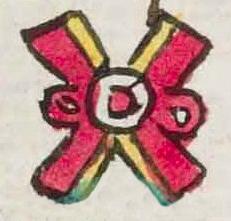olin (Mdz24v)
This element for olin (movement) as been carved from the compound sign for the place name, Olintepec. Here, the olin glyph is an X shape with a small circle in the middle of the intersection and two other small circles just on the outside but also at the intersection. The X is primarily red, but with some yellow outlining. The middle circle is white, but it also has a smaller, concentric red circle inside.
Stephanie Wood
The outside hoops on the X shape are reminiscent of the hoops on a ball court, possibly placed on there intentionally to recall the ball game, given that the homophone olli means rubber and rubber ball. The shape of this glyph has the effect of a four-part quincunx (quadripartite), slightly reminiscent of tonatiuh and xihuitl. Olin is the seventeenth of the twenty signs days of the tonalpohualli calendar, so they all share a temporal meaning. The center of this quincunx may substitute for a "starry eye," which is what we see in another glyph for olin. The starry eye is reminiscent of representations of nighttime, yohualli, and connecting movement to the cosmos and the movement of planets. While we concur with John Sullivan's emphasis on the distinction between olin (movement) and olli (rubber), balls that bounced in a way symbolic of the sun's movement through the ball courts (tlachtli), as explained in The Mesoamerican Ballgame website of the Metropolitan Museum of Art. Other studies of the ball game refer to the sun and the moon or planets, such as a publication of the Maya Archaeologist.
See another representation of olin from the Codex Borbonicus, with the added value of the number four, referring to the date Nahui Olin. This glyph from the Codex Mendoza is quite different from the olin glyph in the Codex Magliabecchiano, which has an added point at the top (in yellow, green, and red) and a shape at the bottom (in green, red, and white) something like the quincunx on the tonatiuh glyph. The x-shape of the Magliabecchiano olin is green on the left and yellow on the right, with an internal red line. The concentric circles on right and left have red centers. The eye at the center is outlined half green and half yellow, with a red lid, white pupil, and white eyeball.
c. 1541, but by 1553 at the latest
movement, movimiento

ol(in), movement, earthquake, https://nahuatl.wired-humanities.org/content/olin
movement
el movimiento, un signo calendárico
Stephanie Wood
Codex Mendoza, folio 24 verso, https://digital.bodleian.ox.ac.uk/objects/2fea788e-2aa2-4f08-b6d9-648c00..., image 59 of 188.
The Bodleian Libraries, University of Oxford, hold the original manuscript, the MS. Arch. Selden. A. 1. This image is published here under the UK Creative Commons, “Attribution-NonCommercial-ShareAlike 3.0 License” (CC-BY-NC-SA 3.0).


